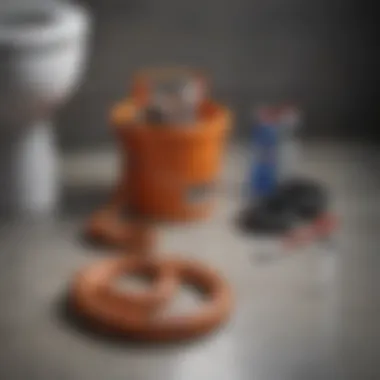Effective Techniques for Snaking a Toilet Drain


Intro
Addressing a clogged toilet drain is a common household issue that often requires immediate attention. Understanding the effective techniques for snaking a toilet can prevent further complications. This guide will discuss the necessary tools, techniques, and safety precautions essential to successfully unclogging toilets. Additionally, it will cover the common causes of clogs and how plumbing snakes can be beneficial in resolving these problems.
The process of snaking a toilet drain is not as daunting as it may seem. With the right knowledge and preparation, homeowners can tackle this problem themselves. By the end of this article, readers will have a solid understanding of how to efficiently maintain their plumbing systems, minimizing downtime and avoiding costly repairs.
Understanding Toilet Clogs
To grasp effective snaking techniques, it is helpful to first understand what typically causes toilet clogs. The majority of blockages are due to:
- Excessive toilet paper usage
- Foreign objects, such as toys or sanitary products
- Mineral buildup over time
- Flushing non-flushable items
Each of these factors can lead to significant disturbances in toilet function. Recognizing these common culprits allows for proactive care and maintenance, ultimately reducing the frequency of clogs.
Tools Needed for Snaking a Toilet Drain
Before beginning the snaking process, it is vital to gather the appropriate tools. The following items are essential:
- Plumbing snake: An essential tool for breaking up and removing clogs. Various sizes and styles exist, so choosing one specifically designed for toilets is advisable.
- Rubber gloves: Protects your hands from bacteria and other contaminants during the process.
- Bucket: Useful for catching any extra water or debris that may come out during snaking.
- Drain cleaner: Optional, but sometimes a safer method to loosen stubborn blockages before using a snake.
Being equipped with these tools allows for a smoother and more efficient process when snaking a toilet drain.
Safety Precautions
Before attempting to snake a toilet drain, it’s important to implement suitable safety measures:
- Wear rubber gloves: This not only protects against contaminants but also provides better grip when working.
- Turn off the water supply: Prevents potential overflow during the snaking process.
- Inform other household members: Safety in communication helps avoid accidents.
Taking these precautions ensures that the task can be performed more safely and effectively.
"Anticipating potential issues helps in being prepared and minimizes risks during repairs."
Finale
In summary, snaking a toilet drain is a practical skill that, with the right tools and precautions, can be performed easily by most homeowners. Understanding the causes of clogs allows for better maintenance and can minimize frustration. This guide serves as a starting point for individuals aiming to maintain an efficient and reliable plumbing system.
Preface to Toilet Drain Snaking
The necessity of understanding toilet drain snaking cannot be overstated. This article focuses on providing effective techniques to address one of the most common issues in home plumbing. By familiarizing yourself with the drainage system and snaking procedures, you can tackle clogs efficiently and reduce the potential for costly repairs or inconveniences.
Understanding the Toilet Drain System
The toilet drain system is designed to remove waste and water. It consists of several key components, such as the toilet bowl, trap, and the waste pipeline that connects to the home's plumbing system. These components work together to facilitate the smooth flow of materials through pipes and into the sewer system.
Over time, however, these pipes can become impacted by various substances, leading to clogs. Understanding how the system works helps homeowners identify the underlying issues when problems arise. It’s crucial to know about the angle and layout of the pipes, as a slope that is too steep or too flat can contribute to blockage issues.


Additionally, toilet drain systems are often interconnected with bathroom sinks and tubs, further complicating potential clog problems. Proper comprehension of the system allows for a more effective snaking process, ultimately resulting in better maintenance and functionality of the plumbing.
Common Causes of Toilet Clogs
Clogs in toilet drains can arise from various sources, and recognizing these can help prevent future issues. Some of the most frequent causes include:
- Excessive Toilet Paper: Using too much toilet paper in a single flush can overwhelm the drain.
- Foreign Objects: Items such as toys, hygiene products, or wipes that are not designed to disintegrate can cause major blockages.
- Feminine Hygiene Products: These items should never be flushed as they do not break down like toilet paper.
- Tree Roots: In cases where plumbing is older or has cracks, root penetration can lead to serious clogs.
- Grease Build-Up: Flushing grease or oily residues can solidify in the plumbing, leading to obstructions.
Addressing these causes requires diligence and knowledge of how materials interact within the plumbing system. By being aware of the most common contributors to clogs, homeowners can adopt better habits to minimize the risk of future problems.
"Proper maintenance is key to ensuring the longevity of your plumbing system."
Ultimately, a proactive approach to understanding the toilet drain system and common clog causes can save time, effort, and money.
Necessary Tools for Snaking a Toilet Drain
An effective snaking process hinges on having the right tools. In this section, we will delve into the essential instruments needed to clear clogged toilet drains. Using appropriate tools not only simplifies the snaking procedure but also enhances the effectiveness of clearing stubborn clogs.
Types of Plumbing Snakes
Plumbing snakes are the primary tools for unclogging toilet drains. They come in various types, each designed for specific purposes. Understanding these types can significantly impact the success rate of your snaking efforts.
- Toilet Auger: This is the most common type of snake used specifically for toilets. It has a long, flexible cable and a curved end that helps navigate the bends in the toilet drain. This design minimizes the risk of damaging the porcelain while effectively breaking up blockages.
- Handheld Auger: This simpler version is often used for light clogs. It is shorter and easier to handle. However, it may not reach deeper clogs effectively.
- Power Auger: For more serious blockages, a power auger or electric snake may be required. These tools are effective for reaching deeper clogs and can save time and effort compared to manual options. However, they require more skill to operate.
- Cable Snake: This type comes with a coiled cable and is useful for softer clogs and obstructions. It can be a handy tool to have in your plumbing repair kit.
Each type of snake serves its purpose and choosing the right one can prevent unnecessary damage to your plumbing system.
Other Essential Tools
Besides the plumbing snakes, several other tools can aid in the snaking process. Having these tools handy can streamline the clearing process and ensure that you are prepared for any unexpected challenges.
- Rubber Gloves: Always wear rubber gloves when dealing with clogs. This will protect your hands from bacteria and other contaminants present in waste.
- Plunger: A good quality plunger can often solve minor clogs before snaking is necessary. It may help to loosen blockages that are just out of reach of a snake.
- Bucket: Keep a bucket nearby to catch any overflow. This ensures that you maintain a clean environment and helps to manage the waste that might spill out during the snaking process.
- Flashlight: A flashlight is useful for illuminating the drain area, especially if visibility is low. It can help you better assess the clog before and during the snaking process.
- Drain Cleaner: In some cases, a good drain cleaner can help dissolve softer blockages before utilizing a snake. Make sure to select a cleaner that is safe for your plumbing system.
"The right tools not only facilitate the snaking process but also ensure your plumbing system remains intact."
In summary, equipping yourself with the necessary tools is critical for successfully snaking a toilet drain. Understanding the types of plumbing snakes and having auxiliary tools ready can save time and prevent further complications during the unclogging process.
Preparing for the Snaking Process
Preparing for the snaking process is a vital step that sets the groundwork for effective and safe unclogging of toilet drains. Neglecting this phase may lead to ineffective results, wasted time, or potential damage to the plumbing system. Understanding how to properly prepare allows for a smoother operation.
Several considerations are integral to this preparation. Firstly, one should ensure that the work area is clear. Remove any items that could obstruct movement or cause accidental spills. This step not only offers convenience but also promotes safety. A clean and organized workspace minimizes the risk of accidents and reaffirms focus on the task at hand.
In addition, assessing the state of the toilet and the nature of the blockage is important prior to starting the snaking process. Not all clogs are created equal. Some may be easily removed with a basic plumbing snake, while others require more specific strategies or potentially professional intervention. Being aware of the type of clog can save considerable time and effort.
Lastly, having all necessary tools at hand, such as a plumbing snake, a pair of rubber gloves, and a bucket, will make the entire process more effective. Unforeseen interruptions can lead to frustration, thus preparedness is key to managing the time efficiently.


Safety Precautions
Safety precautions must be taken seriously to eliminate risks. When working with toilets, one must always consider hygiene. Wearing rubber gloves is non-negotiable. This simple act safeguards against coming into contact with bacteria or waste materials that may be present. Additionally, it is wise to mask any strong odors, especially in homes with older plumbing systems. A face mask can prevent discomfort and protect the respiratory system during the process.
Making sure the area has proper ventilation is equally crucial. Clogs can occasionally release gases, including methane, that may pose health hazards. Always open windows or ventilate the area sufficiently. Remember also to disconnect any electronics nearby to avoid damage from potential splashes.
Creating Access to the Toilet Drain
Creating access to the toilet drain involves ensuring you can freely operate the plumbing snake. First, it is crucial to remove any debris or obstacles around the toilet base. This includes taking away any floor mats or decorations that could hinder your movements.
Next, as a basic step, you may need to remove the toilet tank lid and set it aside carefully. Make sure to take note of how everything goes back together to avoid issues during reassembly. This step allows for easier maneuvers when inserting the snake.
Consider also the adjustment of the toilet seat to provide clear access to the opening. The more unencumbered the area is, the more easily one can insert the plumbing snake. All these preparations will expedite the snaking process and minimize potential frustrations.
Step-by-Step Guide to Snaking a Toilet Drain
When faced with a clogged toilet, knowing how to effectively snake the toilet drain is crucial. This guide aims to provide clear, methodical steps to ensure that individuals can tackle this common household issue without professional help. Mastery of these techniques not only empowers homeowners but also prevents further complications that can arise from improper methods. Furthermore, understanding the snaking process allows for a greater appreciation of plumbing systems in general.
Inserting the Snake Into the Drain
The first step in the snaking process is inserting the plumbing snake. This can be a delicate operation. Begin by removing the toilet lid and setting it aside safely. It is essential to flush the toilet beforehand to clear any excess water from the bowl. This will allow for better visibility and access to the drain.
To insert the snake, carefully push the end of the snake into the toilet bowl. You should aim to place the auger, or the coiled end of the snake, into the drain opening. Be gentle yet firm to avoid damaging the porcelain. As the snake is pushed deeper, ensure that you maintain a steady hand on the handle for better control.
Rotating the Snake
Once the snake is adequately positioned, the next step is rotating the snake to break up the clog. This action is significant as it effectively enables the snake to navigate through bends and turns within the toilet drain. Generally, rotate the handle clockwise while pushing downward.
The rotation creates a scraping effect on the blockage. This is key because it will either break the clog apart or latch onto it. Pay attention to any resistance felt during this stage. If you encounter a hard blockage, changing the angle slightly can help the snake maneuver through obstacles. This step will require patience; do not rush or force the snake, as doing so may cause damage to your pipes.
Retrieving the Snake
After engaging the clog, the final stage is retrieving the snake. Slowly pull the snake back while maintaining the same rotational motion. This action helps reduce the chance of debris being left behind, which can create further issues down the line.
Inspect the snake for any materials that have been collected. It is good practice to clean the snake after use, as this helps maintain sanitation and prevents future clogs from becoming worse. Finally, flush the toilet to ensure that the drain is functioning as it should.
"Proper technique during snaking is essential for maintaining an effective plumbing system."
Identifying and Dealing with Stubborn Clogs
Understanding how to effectively handle stubborn clogs is crucial for maintaining a functional toilet drain. Toilets often face various blockages, and not all are simple to resolve. Recognition of the type of obstruction is the primary step in determining the best approach. This awareness can save time and effort as you choose from DIY methods or decide if a professional is necessary.
Recognizing the Type of Clog
Identifying the nature of the clog can significantly influence your strategy. There are common types of clogs that typically occur:


- Soft Clogs: These result from organic materials, such as toilet paper or waste. They often dissolve partially or can be broken up with a plumbing snake.
- Hard Clogs: Foreign objects, such as toys or sanitary products, create hard clogs. They require more effort to dislodge and may not break down easily.
- Grease and Scale Build-up: In older plumbing systems, grease or mineral deposits may accumulate, complicating the clogging issue. Special techniques may be required to remedy these.
To effectively diagnose the problem, observe the symptoms when flushing. A slow drain usually indicates a softer clog, while complete blockage requiring repeated attempts to flush means it may be more severe. Knowing what you're dealing with helps prioritize your approach.
When to Call a Professional
While certain clogs can be managed with basic tools and techniques, others require professional assistance. Signs indicate when it is prudent to engage an expert:
- Persistent Clogs: If snaking does not alleviate the problem after repeated attempts, it may suggest an underlying issue needing professional tools or skills.
- Multiple Fixtures Affected: If other sinks or bathtubs are also showing slow drainage or backup, the issue could be systemic rather than isolated.
- Complexity Beyond Expertise: If you notice unusual smells, sounds, or any visible damage to piping, this is a clear signal to consult a plumber.
It is essential to know when to step back and seek support. Ignoring signs of serious blockage can lead to larger plumbing problems and, ultimately, costly repairs.
Professional plumbers bring advanced equipment, expertise, and experience that can resolve complex issues that a homeowner might not manage effectively. Always weigh the risks and potential damage before continuing to physically tackle a clog that seems unyielding.
Post-Snaking Maintenance
Post-snaking maintenance is an essential aspect of plumbing care often overlooked by homeowners. After successfully unclogging a toilet drain, it is crucial to ensure that the toilet remains functional and to implement preventive measures that can help avert future clogs. This segment will delve into the importance of testing the functionality of the toilet and adopting strategies for preventing future blockages.
Testing the Functionality of the Toilet
After completing the snaking process, the first step is to test if the toilet is functioning properly. To do this, follow these simple steps:
- Flush the toilet: Observe how the water drains and listen for any unusual sounds.
- Check for leaks: Look around the base of the toilet and the water supply line for any signs of leaking.
- Inspect the flush mechanism: Ensure the flapper valve is sealing properly and the tank fills efficiently.
If the toilet flushes normally and there are no leaks, the snaking process has likely been successful. However, it is prudent to keep an eye on the toilet over the next few days. If you notice any sluggishness in flushing or a recurring issue, further investigation is warranted. Testing the functionality is crucial to achieving long-term satisfaction with your plumbing.
"Post-snaking maintenance not only ensures your toilet works efficiently but also helps maintain the integrity of your plumbing system."
Preventive Measures for Future Clogs
Taking steps to prevent future clogs can save time, money, and a great deal of frustration. Here are several effective strategies to consider:
- Regular cleaning: Use appropriate cleaning products to maintain a clean toilet bowl. This helps prevent buildup of materials that can lead to clogs.
- Mindful usage: Be cautious about what you flush down the toilet. Avoid flushing non-biodegradable items such as wipes, feminine hygiene products, and excessive toilet paper.
- Install a toilet strainer: A toilet strainer can catch debris and prevent it from slipping down the drain.
- Routine inspections: Schedule periodic plumbing inspections to identify potential issues before they escalate. This proactive approach can save you from severe plumbing problems.
- Educate family members: Ensure everyone in the household understands what can and cannot be flushed. Awareness is key to preventing clogs.
By implementing these preventive measures, homeowners can significantly reduce the likelihood of future clogs, ensuring a smoother experience with their plumbing. Post-snaking maintenance not only focuses on immediate fixes but also establishes a road map for plumbing health moving forward.
The End
Key benefits include understanding the underlying causes of clogs, which can help prevent future issues. By being proactive and equipped with appropriate tools like a plumbing snake, homeowners can save money and avoid the inconvenience of constant plumbing issues. Moreover, knowing when to seek professional help can significantly reduce stress and potential damage to plumbing systems.
In summary, implementing effective snaking techniques maintains the functionality of toilets and ensures a smoother plumbing experience. The readers should take these insights and consider regular maintenance practices. This proactive approach can lead to a less troublesome and more efficient home plumbing system.
Final Thoughts on Toilet Drain Maintenance
Maintaining a toilet drain is a fundamental aspect of home care. Regular checks and preventive measures, such as knowing how to effectively snake a drain, are crucial. While occasional blockages may arise, the knowledge gained from this guide equips homeowners to tackle these issues confidently.
- Regular Maintenance: Keeping an eye on what goes down the toilet can minimize future clogs.
- Understanding Preventative Techniques: Familiarizing oneself with effective maintenance tasks can save homeowners time and money.
- Investing in Quality Tools: High-quality plumbing snakes and other tools can make snaking a pleasure rather than a chore.
"Predicting clog issues before they arise is key to maintaining a properly functioning toilet drain system."
In closing, consider these practices as part of a broader home maintenance routine. Educating oneself about toilet care will lead to a more informed, empowered approach to home plumbing management.















